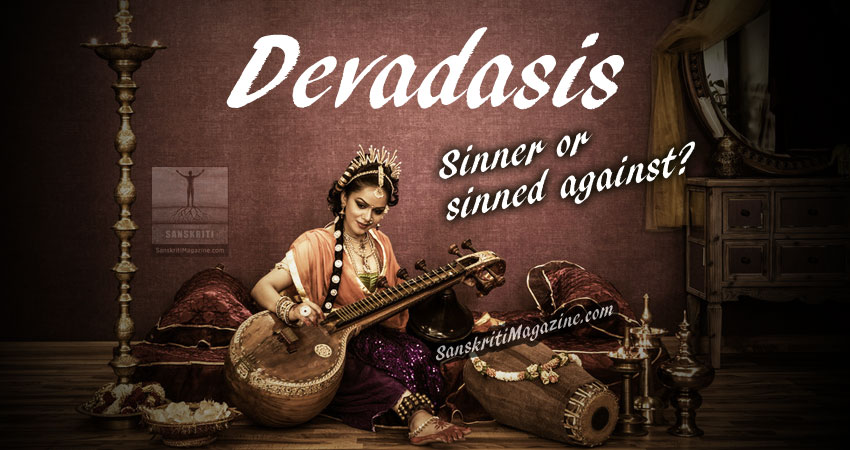In some parts of India a few centuries ago a practice developed under which a few women were made wives of god and named as Devadasis, Jogins, Basavis, Kalawants, Paravatis or Mathammas. These wives of God lived in or around the temples. They performed some duties at the temples and participated in the religious functions. They were an integral part of many large Hindu temples. In addition to their religious duties, the Devadasis were a community of artists. They presented dance and music performances at the temple as well as at private functions. It was customary for the elite to invite devadasis at marriages and family functions.
Readable writings on devadasis are dominated by two categories of writers:
- Leftist intellectuals who spare no opportunity to attack any religious institutions especially the ones that have not received a favourable mention in international Marxist literature
- Christian Missionaries and their protégés. These writers have been using the institution of devadasi as a stick to beat Hindu religion and Indian culture. Unfortunately, many Indians are not aware of the true history of devadasis. This prevents them from answering the smear campaign that has been going on for more than a century.
The devadasis developed and preserved the classical dances of India. Bharatnatyam is a modern incarnation of the sadir dance performed by devadasis of Tamil Nadu. Odissi was performed by devadasis of temples in Orissa. The contribution of devadasis to music is also significant.
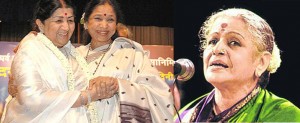
Though not widely known, many of India’s greatest contemporary dancers, singers and instrumentalists are from a devadasi lineage. One such artist unashamed of her devadasi lineage is Kishori Amonkar, one of India’s most extraordinary classical singers. MS Subbulakshmi, Lata Mangeshkar and her sister Asha Bhonsle (the three most renowned women singers of India) trace their lineage to devadasi community. Devadasis, as a community, developed distinct customs, practices and traditions that were best suited to enable them to live as artists without suppressing their physical and emotional needs. This professional community was controlled by women and was matriarchal.
A search for the devadasi practice in books having reference of prostitution is bound to draw a blank since it would have been unimaginable at that time to link the two subjects (devadasis and prostitutes).
Reference to dancing girls in temple is found in Kalidasa’s “Meghadhoot”. It is said that dancing girls were present at the time of worship in Mahakal Temple of Ujjain. Some scholars are of the opinion that probably the custom of dedicating girls to temples became quite common in the 6th century A.D. as most of the Puranas containing reference to it have been written during this period. Several Puranas recommended that arrangements should be made to enlist the services of singing girls at the time of worship at temples. There can be no denial of the fact that by the end of tenth century, the total number of devadasis in many temples was in direct proportion to the wealth and prestige of the temple. During the medieval period, they were regarded as a part of the normal establishment of temples; they occupied a rank next only to priests and their number often reached high proportions. For example, there were 400 devadasis attached to the temple at Tanjore; so also at Travancore.
About a century ago, a campaign was launched to portray devadasis as prostitutes and as immoral women. The smear campaign continues to this date and it has become customary to talk of abolition of the ‘evil’ of devadasi system. The system was legally abolished many years ago in all states where the practice was prevalent. The institution is almost dead and exists today as a fossilized version of its original form. It cannot be anyone’s intention to revive the practice since the necessary supporting institutions do no longer exist. That should not, however prevent one from looking at the truth about devadasis who were not (and a majority are not even today) prostitutes.
It must be mentioned that the devadasi custom had a very prestigious status. The devadasi who was drafted from the leading or ruling families in a community had the status of the wife of the patron deity of the community. They also played many types of roles in the ritual and religious life of the community. So, as an obligation, the temples and the society maintained them. The Devadasis were also persons of much skill and ability and were good dancers and singers and provided recreation to art-loving people. Even till recent times (postindependence), some Devadasis were involved in teaching music, dance and theatre in their local area in South India. Temples in Goa, Tanjavor, Puri, Mathura, Mysore etc. provided good examples of the prevalence of devadasi as temple singers and dancers.
The most unfortunate victim of the smear campaign has been the poor woman who has been portrayed as a prostitute. She was at one time a respected member of the community and was welcome in every house on even the most auspicious occasions. Suddenly, she was painted black without any compassion or empathy. She was an artist who kept classical traditions of dance and music alive for centuries. But the so-called social reformers ignored this aspect of her work and launched a movement asking people to boycott her performances. These pseudo-reformers destroyed her sources of livelihood and pushed her into prostitution. Surely, no woman deserves to be treated in the manner that this wife of god has been treated.
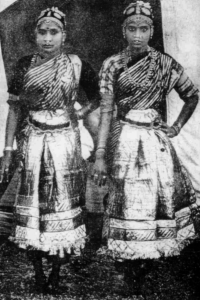 Reformist or Abolitionists conceived Devadasi practice as a social evil and considered every devadasi to be a prostitute. The missionaries branded the devadasi as a harlot and had her legally outlawed. Few Hindus know this and fewer still can comprehend how a society that once called her nityasumangali, “the ever-auspicious woman,” could later chase her into the streets. The first anti-nautch and anti-dedication movement was launched during 1880-90.
Reformist or Abolitionists conceived Devadasi practice as a social evil and considered every devadasi to be a prostitute. The missionaries branded the devadasi as a harlot and had her legally outlawed. Few Hindus know this and fewer still can comprehend how a society that once called her nityasumangali, “the ever-auspicious woman,” could later chase her into the streets. The first anti-nautch and anti-dedication movement was launched during 1880-90.
“Their main aim was to do away with this system. Reform Lobbyists were drawn mainly from missionaries, doctors, journalists and social workers. They urged the abolition of all ceremonies and procedures by which young girls dedicated themselves as Devadasis of Hindu shrines. …These anti-nautch campaigners began their attack on the devadasi system in 1882. They organized seminars and conferences to create a public opinion against the devadasi system. In the later part of 1892 an appeal was made to the Viceroy and Governor General of India and to the Governor of Madras. This appeal also defines the position of the anti-nautch movement.” (Jogan Shankar, 1990)
The following are some extracts from the Memorandum submitted by Hindu Social Reforms Associations:
- That there exists in the Indian community a class of women community commonly known as nautch-girls.
- That these women are invariably prostitutes.
- That countenance and encouragement are given to them, and even a recognized status in society secured to them, by the practice which prevails among Hindus, to a very undesirable extent, of inviting them to take part in marriage and other festivities, and even in entertainments given in honour of guests who are not Hindus.
The reply from the Viceroy said “You base your request upon the statement that these women are invariably prostitutes and that it is therefore, undesirable to countenance, or encourage them, in any way. …. He has, on one or two occasions, when traveling in different parts of India, been present at entertainment of which a nautch formed a part, but the proceeding were as far as His Excellency observed them, not characterized by any impropriety, and the performers, were present in exercise of their profession as dancers, in accordance with the customs of the country.”
Even the Governor of Madras replied in the same line.
Using the declamatory and journalistic skills at their disposal to full effect, the vigour of the Anti-nautch campaign led to the complete suppression of the sadir and its secular performance much before formal legislation was enacted against temple dedication in 1947.
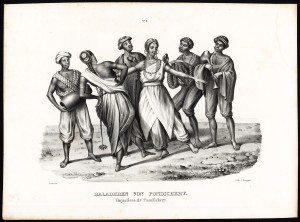 “By the 1920s the Anti-Nautch agitation had become inextricably linked up with the communal politics of the Dravidian movement. The abolition of the practice of female dedication became a powerful political and legislative cause espoused by the backward nonBrahmins as part of the overall Self-Respect campaign initiated by Ramaswami Naicker in 1925.”
“By the 1920s the Anti-Nautch agitation had become inextricably linked up with the communal politics of the Dravidian movement. The abolition of the practice of female dedication became a powerful political and legislative cause espoused by the backward nonBrahmins as part of the overall Self-Respect campaign initiated by Ramaswami Naicker in 1925.”
“The aggressive anti-Brahminism and anti-ritualism of the Backward Classes Movement of the South provided the men of the devadasi group with a powerful ideology with which to overcome the humiliation of the Anti-Nautch campaign and fight for dominance both within the household and wider political society.
With the increased politicization of Brahmin-non-Brahmin cleavages in Madras State, it was entirely to be expected that the revival of the dance in more ‘correct’ society would be pressed forward by the Brahmin dominated Congress and those sympathetic to the cause of Indian cultural and political nationalism. At the same time, these antagonisms surfaced in the form they did because of the imposition of a colonial framework of formal confrontation which:
- greatly accelerated the politicization of the Indian people and
- provided the very rhetoric and the facts on which political action was based.” (Amrit Srinivasan, 1985)
The irony was that the Devadasi, who was a non-Brahmin, became a victim of the politics of anti-Brahminism of Dravidian parties on one hand and of the Christian missionaries and colonial rulers on the other hand. The support to devadasis came from two unexpected quarters – Brahmins and Theosophists.
Voices against the so-called reformers are as old as the “anti-nautch” campaign. Annie Besant, Rukmini Arundale and Theosophical Society of India did a commendable job in preserving the dance traditions of devadasis. Yet, there is not much appreciation (or even realization) for the efforts of the revivalists who were devoted to the great cultural traditions of Bharat (India). The feminist matriarchal community of devadasis provided necessary atmosphere for the pursuit of arts by some women who were so inclined. With the changing times, the customs and practices of the community might have become unsustainable. That cannot be any reason for misrepresenting the history and maligning the few women who still practice the tradition.
The aggressive anti-nautch movement’s campaign was followed with complete suppression of the dance of devadasi and its secular performances much earlier than formal legislation. During the same period there emerged a movement urging the ‘revival’ of Sadir or traditional dance of Devadasis. These revivalists feared that the emergence of anti-nautch movement would lead to a ban on classical dance, which was performed only by Devadasis. They argued that the Devadasi dance was a sacred tradition, worth preserving.
The reform movement utilized the British official machinery, regional party politics and the rhetoric of rationalism and empiricism to achieve its ends. The revival movement on the other hand consciously stepped outside the requirements of state electoral politics and western scientific traditions. The movement received strong support from Theosophical Society of India, whose anti-official stance and strong interest in Indian Home Rule bound them with the revival of the dance.
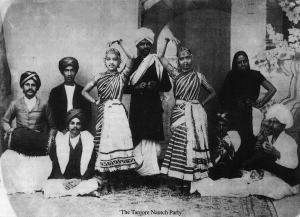 Pioneers like Madam H.P. Blavatsky and Colonel H.S. Oclott, the founding lights of Theosophical movement had undertaken an extensive tour of South India and propagated the revival of devadasi institution and the associated art of Sadir. They gained support from all sections of the native elite by their public denouncement of western Christian morality and materialism. In 1882, Theosophical Society of India had set up its headquarters in Adyar, Madras with the set goal of working towards the restoration of India’s ancient glory, her art, science and philosophy.
Pioneers like Madam H.P. Blavatsky and Colonel H.S. Oclott, the founding lights of Theosophical movement had undertaken an extensive tour of South India and propagated the revival of devadasi institution and the associated art of Sadir. They gained support from all sections of the native elite by their public denouncement of western Christian morality and materialism. In 1882, Theosophical Society of India had set up its headquarters in Adyar, Madras with the set goal of working towards the restoration of India’s ancient glory, her art, science and philosophy.
The support later given to revival of Sadir as Bharatnatyam by Theosophical Society was largely due to the efforts of Rukmini Arundale, an eminent thesophist herself. She was groomed by Annie Besant and the elders of the Theosophical heirarchy as the chosen Vehicle for the World Mother. She took up the cause of evolution of Sadir into Bharatnatyam. The Theosophical Society provided the necessary funds and organization to back her as the Champion for India’s renaissance in the arts especially Bharatnatyam.
The Devadasi was (and is not) a ‘prostitute’. It is indeed a great insult to brand as prostitutes the women who kept classical dance forms like Bharatnatyam and Oddisi alive for centuries. The lack of empathy shown by reformists towards the Devadasis is indeed appalling and smacks of an imperialist and colonialist bias against everything Indian (and Hindu). It should come as no surprise that there have been no mass movements against the practice of Devadasi, except for the period when the anti-dedication movement could ride on the anti-Brahminical and anti-ritualism movement of DMK in Tamil Nadu, aided by the colonial masters.
The anti-nautch movement paved the way for anti-dedication movement. Today it represents nothing more than a brothel where women are mistreated and abused.
PRESENT STATUS:
Even after decades of legislation abolishing the practice of Devadasis, the practice of dedicating girls to temples continues to the present day. It is important to understand the reasons that force parents to push their girls into a life of misery and prostitution. In a study conducted by Joint Women’s Programme, Bangalore for National Commission for Women, it is reported as follows (Page No. 101):
“Following are some of the reasons cited for dedication:
- Being a blind, a deaf or a dumb or a crippled girl
- Well being of the family
- No male issues in the family
- Mother was a devadasi
- Only female child in the family
- Followed from generations
- Poverty
- Father had undergone an operation and vowed to fulfill
- It was a religious ritual
- To appease Gods for the well-being
- Father’s brother made her a devadasi
- Due to skin ailments”
Asha Ramesh in her study gives the following reasons:
“Dedication to the Goddess or God was justified on the following grounds:
(a) If the parents were childless, they vowed to dedicate their first child if it happened to be girl.
(b) If there were no sons in the family, the girl child was dedicated and could not marry as she becomes a ‘son’ for the family (earning the family’s livelihood)
Yet another economic reason contributed to the dedications. If the girl’s family had some property, the family ensured that it stayed within the family by turning the girl into ‘son’ by dedicating her.
If a girl develops ‘jat’ (matted hair) she was dedicated as it was believed that she had received summons from the goddess to serve her.”
Girls are generally dedicated at a young age, between the ages of eight to ten. Various modus operandi are adopted by the recruiters to ensure the entry of young girls.
In the study by Joint Women’s Programme a survey was carried out of 375 Devadasis. The survey showed that the practice of offering girls as Devadasis is followed mainly by scheduled castes and other backward communities. In addition to religious faith, there are other factors that have a crucial influence on the decision of parents to donate their daughter to the deity. The economic factor is as important as the religious factor. It is no coincidence that all Devadasis come from poor landless families.
LIFE AFTER DEDICATION:
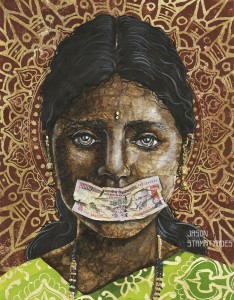 “After dedication of a girl to the temple, she has to take bath everyday early in the morning and should present herself at the temple during morning worship of Yellamma. She is not allowed to enter the sanctum sanctorum. But she will bow to the deity from outside. Thereafter she sweeps compound of the temple. Every Tuesday and Friday she goes for joga along with senior jogatis. During this period she learns innumerable songs in praise of Yellamma and her son Parashurama. If she shows some aptitude to learn playing instruments she will be given training by her elder jogatis. In Yellampura and other villages Devadasis do not dance but this is performed by eunuch companions. The main functions of Devadasis would be singing and playing stringed musical instruments and Jagate. They form a small group and go for joga, from house to house on every Tuesday and Friday.” (Jogan Shankar, 1990)
“After dedication of a girl to the temple, she has to take bath everyday early in the morning and should present herself at the temple during morning worship of Yellamma. She is not allowed to enter the sanctum sanctorum. But she will bow to the deity from outside. Thereafter she sweeps compound of the temple. Every Tuesday and Friday she goes for joga along with senior jogatis. During this period she learns innumerable songs in praise of Yellamma and her son Parashurama. If she shows some aptitude to learn playing instruments she will be given training by her elder jogatis. In Yellampura and other villages Devadasis do not dance but this is performed by eunuch companions. The main functions of Devadasis would be singing and playing stringed musical instruments and Jagate. They form a small group and go for joga, from house to house on every Tuesday and Friday.” (Jogan Shankar, 1990)
The above is a description of the typical religious duties that are supposed to be performed by a devadasi. This is the bright part of her life. The dark side of her life involves her sexual life. Her initiation into prostitution is not a natural sequel of her dedication, though it eventually might lead to the dark alleys of flesh trade. A devadasi gets a Patron after the deflowering ceremony.
The tough life of a Devadasi really begins after the first Patron deserts her. Temporary alliances lead many of them eventually into prostitution. But all Devadasis do not become prostitutes. Classifying all Devadasis as prostitutes is an insult to the grit and struggle that many of them go through to maintain their sense of honour and self respect.
A tradition that has given so much to the country surely deserves to be treated better than the way biased authors have done. This work is dedicated to and inspired by the women who have survived a century of malicious propaganda with grit, determination and perseverance. They were painted as sinners by the educated urban class. History will no doubt prove these poor women to be more sinned against than sinners.
Although it is a dying “tradition” today, but still as a developing society, we must accept the modern shortcomings and exploitation of our fellow human beings. There have been many programs run by government to end this exploitation and to rehabilitate devadasis and we fully support them!
~ Anil Chawla, excerpted from the book, “Devadasis: Sinner or Sinned Against ?”

